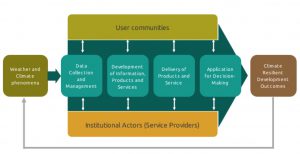Climate Services – Making Them More Impactful Through a Holistic Approach
A growing number of actors develop and offer ‘climate services’, i.e. easily accessible and timely scientific data and information about climate that help people make informed decisions in their lives, businesses, and communities (NOAA 2011). There is a range of information products that are either provided by public actors (such as National Meteorological and Hydrological Services), but also increasingly as commercialised services by private actors and research institutions (see Webber 2017; EU-MACS and MARCO).
In the early days of climate service provision, many cases have been overemphasizing the ‘hard’ components of CS (e.g. equipment and infrastructure for data collection and management) and under-investing in ‘soft’ components (e.g. training, capacity development, communication, stakeholder engagement and decision support).
 Increasingly, there is a recognition of holistic approaches starting from the data collection and management mounting in the application for better and climate-smarter decision making. The World Bank says, for instance, that weather and climate services provision follows a series of individual parts, and that it is essential to appreciate the interdependencies between the parts (see diagram). To be effective, these parts must work together and strengthen each other.
Increasingly, there is a recognition of holistic approaches starting from the data collection and management mounting in the application for better and climate-smarter decision making. The World Bank says, for instance, that weather and climate services provision follows a series of individual parts, and that it is essential to appreciate the interdependencies between the parts (see diagram). To be effective, these parts must work together and strengthen each other.
PlanAdapt’s expertise lies in the integration of all parts and particularly, the ‘soft’ components of the value chain. We constantly learn from and with other stakeholders how best to:
- design processes that guarantee that climate information is developed, produced and visualised in view of the decision to be taken (co-design and co-production);
- support climate service developers in understanding user needs early in the process (brokering role);
- enable users to express their concrete needs (capacity development and brokering role);
- fine-tune approaches to effective stakeholder engagement (participatory scenario planning; transformative scenarios; stretch collaboration; social labs; serious gaming, foresight, design thinking, theory U, co-presencing, open fora, adaptation pathways, participatory modelling etc.) to increase the likelihood of positive outcomes for climate-resilient development;
- take into account and meaningfully assess the capacity levels of involved users and stakeholders in order to ensure the appropriateness of climate services;
- communicate the potential and limits of climate science and information;
- understandably communicate and integrate the (un)certainty related to future climate information in the decision-making process;
- ensure that climate information does not solely focus on the bio-physical impact and exposure level, but are translated and calculated as vulnerability, loss and damage information. It has been shown that this increases the relevance and usability of climate information for good decision-making.
